
SWASTIKAS
& SANSKRIT http://rexcurry.net/swastika3swastika.jpg
SWASTIKAS,
SWASTIKA, SANSKRIT
Many people overuse the word "Nazi" because they do not know the actual
name of the group: the National Socialist German Workers Party (NSGWP).
Other people overuse the shorthand term to deliberately cover-up the group's
actual name, in order to rehabilitate socialism. Most people do
not know that "Nazis" did not call themselves "Nazis" (they called themselves
socialists). The same people are unaware that German socialists did not
call their symbol a "swastika." They perpetuate two more myths:
(1) That the swastika, as an ancient symbol and as a Sanskrit word, represented
the opposite of German socialism; (2) That "Aryan," in the ancient Sanskrit
sense, had no true relevance to German socialists. http://rexcurry.net/swastika.html
The ancient term "swastika" is often translated as "good luck" or "well
being" or "auspicious." The Sanskrit concept of "good luck" fit
the National Socialist view (and every socialist's view, even today) of
socialism.
That is why the swastika was sometimes used as alphabetical symbolism of
overlapping S-letters for "socialism" under the National Socialist German
Workers Party, as shown by the etymologist and symbologist Dr. Rex Curry.
It was turned 45 degrees to the horizontal (to highlight the S-letters)
and oriented in the S-direction.
http://rexcurry.net/swastika3swastika.jpg
See the youtube video at http://www.youtube.com/watch?v=BssWWZ3XEe4
And the ancient swastika concept included socialist ideas. Although the
word "socialism" is modern, socialistic concepts have been around since
the dawn of mankind, causing shortages, poverty, misery and death. That was
the case in India (and much of Asia), and is still the case today there,
and worldwide. The swastika is associated with monks who embrace altruism,
ascetism, renunciation, self-sacrifice and vows of poverty.
The double-S image of the swastika and the word "Socialism," and their
sounds, were (and are) interchangeable. They are, in a sense, onomatopoeic.
They are linked in a way that the four letter n-word is not to the concept
of self-sacrifice (even to the ultimate degree).
http://picasaweb.google.com/rexcurrydotnet/PledgeOfAllegianceIsNazismSwastikaSLettersForSocialism02/photo#s5065541368726324898
"Swastika" and "Aryan" were conceptually related in Sanskrit, long before
the NSGWP existed. People who oversimplify "swastika" as "good luck"
also oversimplify the word "Aryan." In Sanskrit, "Swastika" had a similar
meaning to the word "Aryan," because both included the sense of "fortunate"
or "favored" as in a favored person, who belonged to a fortunate caste,
class, or race. "Aryan" is probably related to the aristoi, the "most
noble," of Greece (Aristotle, aristocracy, aristocrat). The related concept
of "arch" creates nouns that signify people and groups having authority over
others of their class (archbishop; archdiocese; archangel; archenemy, archrival)
or "exemplary" (archetype). Aryan probably included "accomplished,
skillful." The original meaning of the root, pertaining to "skillful assembly"
or "union" might be seen in Latin ars "art," and "architect" and ordo ("order").
The term "Aryan" is related to the word "Iranian" (Iran or Persia).
Professor Curry has shown that the Sanskrit term "swastika" did not merely
mean "good luck" in the modern sense (as is often said). For the higher
classes (and for those who dreamed or aspired) the symbol meant that it
was "good luck" to be in a high caste / race and not a low class / race
(it is sad to note that the high class was sometimes interpreted as the
"Aryan class"). In that way, the sanskrit concept is not dis-similar from
the German socialist use.
Similar to the German symbol, the ancient swastika consisted of two crossed
S-shapes and was drawn as two overlapping S-shapes. German socialists did
not call their symbol a "swastika," but called it a "hakenkreuz" (hooked
cross), because it also consisted of two crossed S-shapes. Etymologists indicate
that in ancient Sanskrit "swastika" combined and used two S-sounds, similar
to the modern word "swastika." Edwin W. Fay wrote in "The American Journal
of Philology" the article "Derivatives of the Root Stha in Composition" and
stated "...Skr. [Sanskrit] svasti-s may be for *sva-st(h)i-s..." (The American
Journal of Philology, Vol. 33, No. 4 (1912), pp. 377-400). Other etymologies
state "from Skt. svastika-s, lit. "being fortunate," from svasti-s "well-being,
luck," from su- "well" + as-, root of asti "(he) is," from root of L. esse
"to be" (see essence)." That etymology even leads to the "esse" sound.
It is often said that German National Socialists altered (and ruined)
the "good luck" meaning of the symbol from its history in India and the rest
of Asia. That leaves a lot out of the whole story. http://rexcurry.net/book1a1contents-swastika.html
If swastikas had "Aryan" etymology in the minds of German socialists,
it included a common dictionary's second meaning: "noble" or "high rank."
They used it to mean a "master race" or "noble class" or "ruling class."
The swastika became an emblem for the cockamamy "super socialist man"
or "new socialist man." http://rexcurry.net/george-bernard-shaw-superman-socialist-swastika-socialism.html
When the swastika was used as alphabetical symbolism of overlapping
S-letters for "socialism" under the National Socialist German Workers Party,
it did not change from a good-luck symbol for German socialists and
their admirers. But for some of the world, the symbol became a bad-luck
symbol for "socialism." http://rexcurry.net/swastika-hakenkreuz-oxford-english-dictionary.html
It is also consistent with India's historic socialism and, as a cosequence,
its historic levels of poverty and misery.
It is consistent with the dogma of a mystical India-Germany promoter
of National Socialism known as Savitri Devi. Known as the "Aryan
Hindu prophetess," she authored a lengthy examination of the Hindu
theory of cyclical history that included Hitler was an avatar or
god come to earth. Born Maximiani Portas, she became a strong
admirer of Hitler in the 1920s, moved to India in 1932 because of its
caste segregation system, and took a Hindu name. Later, her writings
were republished, and she gained new fans in the 1970s as new interest
in National Socialism spread. Devi died in 1982, but the author boasted
that her combination of Hindu religion and Nordic racial ideology became
a bridge between National Socialism and the New Age movements. It was
not the culture of India that drew Devi, but her belief that India
represented the best of racial segregation. Once in India, she
became interested in Hinduism and wed the Brahman A.K. Mukherji in
a marriage of shared ideals that also happened to bolster her shaky
legal status as a resident sympathizer with German National Socialism.
And there are older consistencies with the dogma of another mystical India-Germany
promoter of National Socialism known as Madam Blavatsky of the Theosophical
Society (established 1875
in New York). The TS dogma included oddball
theories about superior races, superior societies, a
"Great White Brotherhood" of masters, sub races, and seven
primary root races, including the "Aryan" race, which Blavatsky
described as superior to some other "races."
In 1888, Blavatsky's group joined with the American National Socialist
Edward Bellamy and his Bellamy Clubs (Nationalist Clubs) to work for
socialism. Edward Bellamy was the author of "Looking Backward" (1888)
an international bestseller known as the bible of National Socialism, and
translated into every major language (including German, Russian and Chinese).
Edward Bellamy was cousin to Francis Bellamy, author of the "Pledge of
Allegiance" (1892) the origin of the stiff-arm salute (the early salute
to the Pledge), later adopted by the National Socialist German Workers
Party.
http://rexcurry.net/roman-salute-oxford-english-dictionary.html
The Bellamys wanted government to take over all schools in order to impose
their "military socialism." When the government granted their wish the
socialist schools imposed segregation by law and taught racism as official
policy. It was a bad example for decades before the NSGWP was formed, and
it even outlasted the NSGWP by more than a decade. http://rexcurry.net/pledge-allegiance-pledge-allegiance.jpg
During the time that the American National Socialist Edward Bellamy worked
with Blavatsky, she and the Theosophical Society used a swastika
symbol. Thus the swastika's association with socialism began in the
USA three decades before it was used by the National Socialist German
Workers' Party.
http://rexcurry.net/book1a1contents-pledge.html
The version of the swastika symbol adopted by German socialists is the
same swastika used in Blavatsky's symbolic brooch.
http://rexcurry.net/bellamy-blavatsky-brooch.gif
Before and after Bellamy's book, Blavatsky continued to promote socialism
in Germany, India and worldwide. At the time this was written,
the Theosophical Society of America (TSA) continued to maintain
its Springfield Branch office at the Edward Bellamy House,
93 Church Street, Chicopee, MA and also its library.
http://rexcurry.net/theosophy-madame-blavatsky-theosophical-society.html
That utopian socialism is consistent with Bellamy dogma and with the totalitarian societies of the socialist Wholecaust (of which the Holocaust was a part): ~60 million slaughtered under the Union of Soviet Socialist Republics; ~50 million under the Peoples' Republic of China; ~20 million under the National Socialist German Workers Party. In 1939, the National Socialist German Workers Party joined as allies with the Union of Soviet Socialist Republics to invade Poland in a pact to divide up Europe, spreading WWII. Even after German socialism was defeated, Soviet socialists continued to pursue their part of the pact they had made with German socialists. Socialists in the USSR and in China went on to kill even more millions of people.
********************
The Oxford English Dictionary (OED) supports Dr. Curry's discovery
that the swastika was used by the Nazi Party to symbolize meshed "S"
letters for "socialism." http://rexcurry.net/swastika-hakenkreuz-oxford-english-dictionary.html
The Oxford English Dictionary (OED) also supports Dr. Curry's discovery
that the "ancient Roman salute" is a myth and that the myth arose from
the early stiff-arm salute of the USA's Pledge of Allegiance. http://rexcurry.net/roman-salute-oxford-english-dictionary.html
Wikipedia is helping to announce the new discoveries. Opinion Editorials reported on the many references to Dr. Curry's research on Wikipedia. It might be the most referenced historical work of its kind on Wikipedia. Wikipedia writers have reviewed and verified the research. Some Wikipedia writers use it without attribution in apparent attempts to bolster their own credibility. http://rexcurry.net/crypto-cryptography-cryptology.html
Read about the Cryptologist Dr. Rex Curry on Brazilian Integralism and
the Brazilian Integralist Action Party
http://rexcurry.net/swastika-brazilian-integralist-action-aib-greek-sigma.html
**********************
Re Savitri Devi - The couple worked on behalf of the Axis powers
during the late 1930s and early '40s, with Devi claiming that Mukherji
put militant nationalist Subhas Chandra Bose in contact with
the Japanese authorities. Devi also wrote about animal rights. (As an
interesting and probably unrelated aside, there is a current Indian actress
known as Swastika Mukherjee).
The TS dogma included oddball theories about
superior races, superior societies, a "Great White
Brotherhood" of masters, sub races, and seven primary
root races, including the "Aryan" race, which Blavatsky
described as superior to some other "races" (Cf. H. P. Blavatsky,
The Secret Doctrine 1:642; G. de Purucker, Fundamentals of
the Esoteric Philosophy,. 294-5; also "The Root-Race and Its
Sub-Divisions," Studies in Occult Philosophy, pp. 35-9). See
image at
http://rexcurry.net/theosophy-ocean-aryan-press-william-judge1893.JPG
Theosophists saw in the Nationalist Movement a practical means to further
their "ideal of universal brotherhood." (see Arthur E. Morgan
in his biography, Edward Bellamy, 1948, pp. 260-75;
see also The Key to Theosophy by H. P. Blavatsky, pp.
44-5. -- K.V.M.]
(The Esoteric World of Madame Blavatsky: Reminiscences and Impressions
by Those Who Knew Her by Daniel H. Caldwell: Chapter 14, Germany
and Return to India 1884-1885; Chapter 15, From India to Italy and
Germany, 1885; Chapter 16, Germany 1886).
Rudyard Kipling used a swastika on dust jackets of his books, and it
was used by Baden Powell for his original Medal of Merit,though both of
those were flat on one side, as if drawn within a square, and Kiplings was
Z-oriented.
The Swastika in Buddhism, Buddhist shrines, and other places in Asia can
have the arms point left or right, and that was the case historically.
What is unique about the symbol of the National Socialist German Workers'
Party is that it is squared on the arms/corners, but it was eventually
turned 45 degrees to the horizontal (to highlight the S-shape) and always
pointed in the S-direction (not the Z-direction) because they used it sometimes
to symbolize meshed S-letters for "Socialism" under the National Socialist
German Workers' Party (e.g. on their main flag). A rune analogy is correct,
because the German Socialists also used it to resemble the rune that corresponds
to the S-letter, as they also did for the S.S. Division with its alphabetical
meaning. Similar alphabetical symbolism can still be seen every day
on Volkswagens, as the swastika-style VW logo / emblem (using meshed
letters). Those are all discoveries of the noted historian Dr. Rex Curry (author
of "Swastika Secrets") http://rexcurry.net/book1a1contents-swastika.html
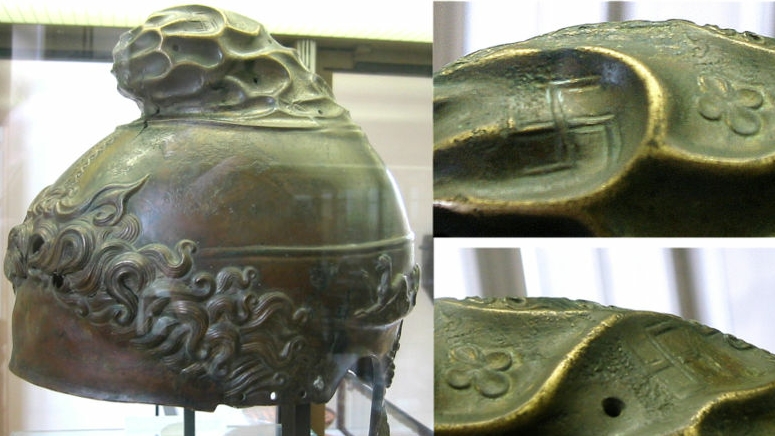


No one knows why the swastika was the symbol for Nazism and almost no one knows how the word "Nazi" originated. The two mysteries are related.
The word "Nazi" is short for "National Socialist German Workers’ Party."
The media and the government schools rehabilitated socialism's horrid
reputation, by avoiding the full phrase, and by overusing the abbreviation
"Nazi" instead of the full phrase. The media and the government
schools are now victims of their own coverup and they have joined the
masses in forgetting "National Socialist German Workers’ Party."
Nazis were socialists, and they used the swastika as a symbol for socialism.
The ancient symbol resembles two "S" letters (for "socialism") overlapping.
An old-style swastika was turned 45 degrees to the horizontal to highlight
the letter "S" shape for "socialists" unified. Here is a picture
at http://rexcurry.net/swastika3a1.JPG.
And here is a picture of another example of the National Socialists using
stylized double "S" letters similar to those of the socialist swastika
http://rexcurry.net/swastikass.jpg.
The media and the government schools no longer know the origin of "Nazi"
nor the related meaning of the swastika. The few who do know,
do not want to explain. The meaning is "socialism."
It started in 1919, when Hitler joined the German Workers' Party, a socialist
group. The group sought a new name that would combine other
socialist groups. Other groups used terms like "National" and
"Socialist" in their titles, and Hitler's group adopted "National Socialist
German Workers' Party."
"Swastika" is sometimes said to mean "all is all" which eerily supports
a symbol for totalitarian socialism.
In the modified swastika, the overlapping "S" symbolizes the union of
different socialists.
It fit the German socialist view of merging all socialist groups into one
leviathan.
| The
swastika was used as
for "Socialism" http://rexcurry.net/book1a1contents-swastika.html See the Swastika image http://rexcurry.net/swastika3swastika.jpg Swastika photograph The stiff-arm Nazi salute originated in the USA's Pledge of Allegiance http://rexcurry.net/book1a1contents-pledge.html View a photograph of the early Pledge of Allegiance and its Nazi salute http://rexcurry.net/pledge-allegiance-pledge-allegiance.jpg Francis Bellamy, socialist and author of the Pledge and its notorious salute http://rexcurry.net/pledgetragedy.html Image of straight arm salute from Francis Bellamy http://rexcurry.net/pledge-utah2.jpg Pledge Of Allegiance photograph Edward Bellamy, socialist and the swastika http://rexcurry.net/theosophy-madame-blavatsky-theosophical-society.html Image of swastika under Edward Bellamy http://rexcurry.net/swastika3clear.jpg Swastika image Hear audio on worldwide radio at http://rexcurry.net/audio-rex-curry-podcast-radio.html Fan Mail http://rexcurry.net/pledge_heart.html |
| Support the fight against
the National Socialist German Workers' Party and its atrocious
legacies in modern politics. For more information regarding Nazi policies in the USA see http://rexcurry.net/police-state.html |
Swastika photograph
Swastika Image http://rexcurry.net/swastika3swastika.jpg |
Photos http://rexcurry.net/swastika-sum.jpg
MORE GRAPHICS ON ENTIRE PAGE 
The sick socialist swastika is exposed! |
|
|
The swastika myth exposed:
and "swastika socialism"
Although the swastika was an ancient symbol for "good luck" in India, that is not why it was used by the National Socialist German Workers' Party. The swastika changed from a good-luck symbol for "well-being," to a bad-luck symbol for "socialism." Under the Nazis it was called a "Hakenkreuz," not a "swastika." One reason why it was chosen and/or maintained by the Party is because they used it to symbolize two "S" letters for "Socialism." Some novices make the absurd argument that during the 25 year existence of the horrid Party no Nazi noticed the "S" shapes nor attached any meaning (nor anyone in the SS Division). They also ignore the fact that the Party leader was an ex-artist. According to the book "The Swastika - Symbol beyond redemption?" by Steven Heller, the swastika symbol was stylized in a version by the famous German designer Wilhelm Deffke prior to 1920. Professor Klaus Winterhager, graphic artist, has also lectured on "Signs of Power" and researched that the swastika was draft of the famous graphic artist and label designer Wilhelm Deffke. According to Deffke's former assistant, Deffke redefined an ancient Germanic sun wheel and German socialists chose it as their symbol but reversed it. Heller, Winterhager, and Deffke's assistant express surprise that German socialists took the symbol without thought of copyright or compensation to Deffke. All three people thus overlooked the discovery by Dr. Rex Curry that the symbol was no longer the same symbol. The symbol had been reversed and was no longer an ancient German sun wheel, but rather overlapping "S" letters for "socialism." It was a significant and meaningful innovation that even Deffke did not foresee. Dr. Curry's work has changed the way people think about the swastika. Socialists socialized the swastika in more ways than one. On May, 19, 1933, Josef Goebbels' announced the "Law for Protection of National Symbols." The anti-capitalist attitude of the socialists banned use of the swastika for individual or commercial purposes. The swastika was socialized for official purposes for the glory and worship of government. Germany's socialist swastika had the same meaning as the earlier Soviet Swastika and the Hammer and Sickle: The German and Soviet swastikas were two "S" letters that represented socialists joining together; the hammer and sickle represented socialists joining together, particularly workers joining with peasants, or factory workers joining with agricultural workers. http://rexcurry.net/ussr-socialist-swastika-cccp-sssr.html The German term for "swastika" is "Hakenkreuz" ("hooked cross") because the symbol represented two separate pieces crossed (two "S" shaped pieces). Around November 7, 1935, the war (or military) flag was announced under German National Socialism. "Soldiers of the armed forces, " Adolf Hitler said "The swastika cross shall be for you a symbol of the nation's unity and purity, an emblem of the National Socialist Weltanschuung [world view] and a pledge for the Reich's freedom and strength." In Mein Kampf, the German socialist leader referred to the socialist swastika and the flag: "In red we see the social idea of the movement, in white the nationalistic idea, in the swastika the mission of the struggle for the victory of the Aryan man, and, by the same token, the victory of the idea of creative work..." (pg. 496-497). In German the swastika reference was: "im Hakenkreuz die Mission des Kampfes für den Sieg des arischen Menschen und zugleich mit ihm auch den Sieg des Gedankens der schaffenden Arbeit," In his own words, Hitler stated that the swastika referred to work (labor) and mimicked the Soviet's "new" swastika replacement, the Hammer and Sickle (two tools of workers). Hitler states that the Hakenkreuz (hooked cross) represents two crossed "S" shapes known as "sieg" symbols. Those "S" letters were used for "S" in other German socialist symbolism. He made overlapping use of the word "victory" or "sieg" in German. The red color represented socialism as the "social idea of the movement" for which Hitler claimed the National Socialist German Workers' Party was struggling for victory. The so-called "swastika" represented two "S" letters for "socialism" and is related to "Sieg Heil!" in the sense of the NSGWP's cry of "Hail to the Victory of Socialism!" His use of the term "arischen" for Swastika Socialism mimicks the Soviet swastika and the Soviet hammer and sickle in the effort to glorify workers (represented by their tools in the hammer and sickle) as the new super soviet socialist men. http://rexcurry.net/george-bernard-shaw -superman-socialist-swastika-socialism.html German socialists were heavily influenced by earlier Soviet socialists, even in regard to concentration camps, purges, and genocide. In 1939, the Union of Soviet Socialist Republics and the National Socialist German Workers’ Party joined as allies to invade Poland in a Pact to divide up Europe, spreading WWII. http://rexcurry.net/socialists.html They USSR embraced the swastika symbol even more then, and the hammer and sickle was displayed proudly next to and in partnership with the socialist swastika. Hitler also wrote: "Two years later, when our squad of hall guards had long since grown into storm detachments, it seemed necessary to give this defensive organization of a young Weltanschhauung a particular symbol of victory, namely a Standard." In German it was: "Zwei Jahre später, als aus der Ordnertruppe schon längst eine viel tausend Mann umfassende Sturmabteilung geworden war, schien es nötig, dieser Wehrorganisation der jungen Weltanschauung noch ein besonderes Symbol des Sieges zu geben: die Standarte." In the only comments on the swastika by Hitler, the Sturmabteilung was specifically referenced. The Sturmabteilung had a well-known Nazi banner that included the swastika and another banner also utilizing another stylized "S" symbol. ******************** The swastika myth has been exposed. Debunked is the claim that the swastika was used by Hitler as a sankrit sign for “good luck” and stolen from an eastern culture (or that it was reversed for "evil"). http://rexcurry.net/swastikanews.html The myth began in translations of Hitler’s book “Mein Kampf” containing early comments made about the symbol by the leader of the monstrous National Socialist German Workers’ Party (Nazis). Hitler did not use the word "swastika." Hitler used the German word “hakenkreuz.” The most literal translation is “hooked cross.” Most readers intuitively understand “hooked cross” or "crooked cross" or even “hakenkreuz,” but not “swastika.” There is no evidence that Hitler knew “swastika.” The word "swastika" as used in English for the symbol of the National Socialist German Workers' Party was a misleading translation of "hakenkreuz." More support comes from a fan of RexCurry.net who writes: "British propaganda of WWII that I’ve read used 'crooked cross.' ” "Hakenkreuz" is in Adelung's dictionary (of German words) of 1811, and "Swastika" is not. Adelung's reference of 1811 for “Hakenkreuz” predates the "swastika" reference of 1871 in the Oxford English Dictionary (OED) by 60 years. The OED also lists “hakenkreuz” as an English word used in the Times in 1931. Another fan writes: "To judge from the OED, we didn't have a single widely-known term for the symbol in the early 1930's when, suddenly, every newspaper needed one. The OED indicates that for a while, the newspapers imported 'Hakenkreuz.' It would be interesting to know how 'swastika' became the usual name. It seems that Germans didn't have anything to do with it." |
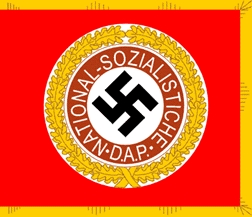
THIS COLUMN HAS EXAMPLES OF ACTUAL GERMAN FLAGS AND BANNERS EVIDENCING THE HAKENKREUZ / SWASTIKA AS "S" SHAPES FOR SOCIALISM. 
It is fascinating to think that of the gazillion times and ways that the National Socialist German Workers Party referred to the symbol of their socialism, many people failed to grasp the full import of what they were saying, and that the words also referred to the "S" shapes of the symbol. 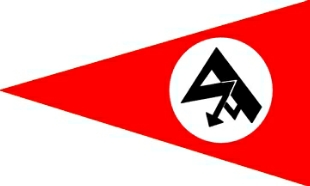
Critics make an absurd argument that for 25 years no one in the National Socialist German Workers' Party ever noticed the swastika's "S" shapes nor attached any meaning (nor anyone in the SS Division). 
The Swastika: A symbol of hate because it is a symbol of socialism. 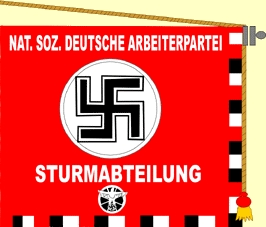

swastika image http://rexcurry.net/swastika2f.jpg 
swastika image http://rexcurry.net/swastika2f.jpg The images shown (on this page or at http://rexcurry.net/swastikanews.html
) are photos or representations of actual banners and flags
used by the National Socialist German Workers' Party.
Two of the flags show the name "National Socialist German Workers' Party" or "National Socialist" incircling or surrounding the swastika. Both swastikas have been turned or face the right to accentuate the "S" shape (turned by the National Socialist German Workers' Party). One of the banners includes an additional word that begins with the letter "S," (Sturmabteilung). That group was specifically referred to in the only comment on the swastika by Hitler. Another banner shows how the National Socialist German Workers' Party used other stylized "S" letters, similar to the stylizing of the swastika. In that banner the swastika itself is overlayed with two additional "S" letters in the common lightning-bolt style of the runes. Another banner shows a single letter "S" in the lightning-bolt style of the runes, sometimes used for youth organizations. There is a pennant with heavily stylized "SA" letters, deliberately designed to evoke the overlapping letter "S" shapes of the swastika. |
|
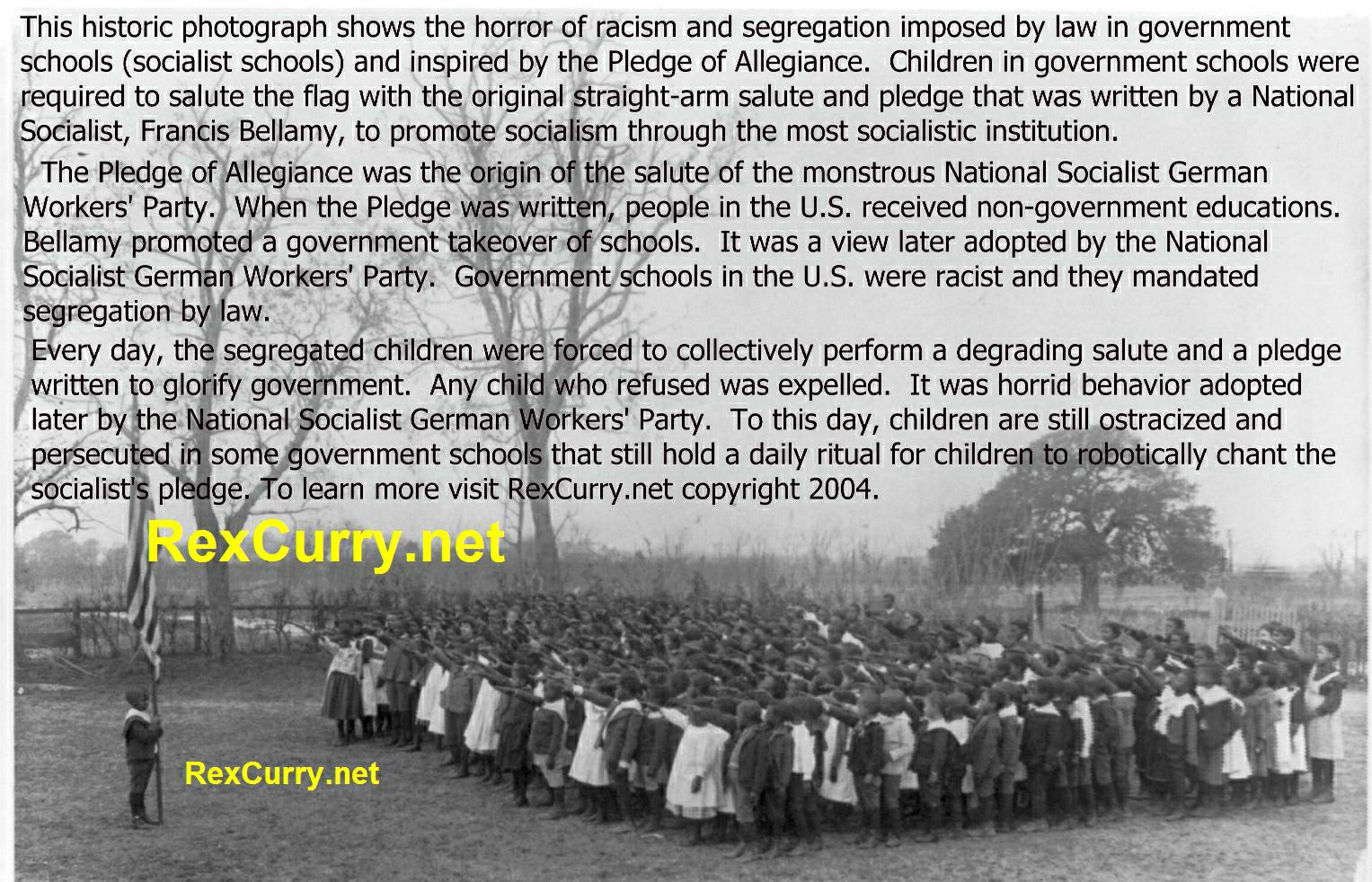
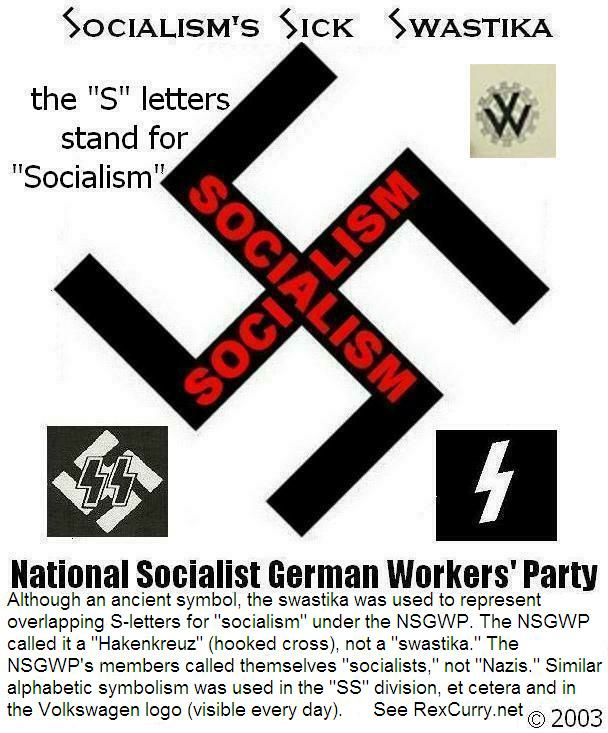



| One argument claims
that the swastika was chosen due to German myths or confusion
about Indo-Aryan or Indo-Iranian heritage. There is no support
for that argument. But if that argument is correct then it supports
the double-S for "socialism." If Nazis used the swastika to
claim an Indo-Aryan heritage, then they saw that heritage evidenced
in ancient Germanic runes for the letter "S" and for their support
of socialism. As an even earlier symbol in Sanskrit, the swastika means "all is all" which eerily supports a symbol for totalitarian socialism. The swastika has also been interpreted as "good luck," or literally "it is good" (Sanskrit is the oldest extant Indo-Aryan language retained in India) and that fit the National Socialist view of merging all socialist groups into one large organization. In ancient times, the symbol might have also represented the sun or a wheel, thus giving rise to the modern terms "socialist sun" and "wheel of socialism" and the "circle of socialism" for the swastika of socialism. If the swastika had any "Aryan" etymology to Nazis it was in the dictionary's second meaning: "noble" or "high rank." They used it to mean a "master race" or "noble class" or "ruling class." That ties into the swastika as a "superman" emblem for the cockamamy "super socialist man." That utopian totalitarianism is consistent with the book "Looking Backward" by Bellamy and with other totalitarian socialist societies: the Union of Soviet Socialist Republics (62 million dead) and the Peoples' Republic of China (35 million dead). For National Socialists, "Aryan" meant the people they liked or, in other words, the people that they didn't hate. |
Swastika Image http://rexcurry.net/swastika3swastika.jpg
Swastika Image |

The above in the German language
of Mein Kampf
{556 Die nationalsozialistische Flagge}
Entwurf an die Öffentlichkeit treten, da es ja möglich war, daß ein anderer einen ebenso guten oder vielleicht auch besseren bringen würde. Tatsächlich hat ein Zahnarzt aus Starnberg auch einen gar nicht schlechten Entwurf geliefert, der übrigens dem meinen ziemlich nahekam, nur den einen Fehler hatte, daß das Hakenkreuz mit gebogenen Haken in eine weiße Scheibe hineinkomponiert war.
Ich selbst hatte unterdes nach unzähligen Versuchen eine endgültige Form niedergelegt: eine Fahne aus rotem Grundtuch mit einer weißen Scheibe und in deren Mitte ein schwarzes Hakenkreuz. Nach langen Versuchen fand ich auch ein bestimmtes Verhältnis zwischen der Größe der Fahne und der Größe der weißen Scheibe sowie der Form und Stärke des Hakenkreuzes.
Und dabei ist es dann geblieben.
In gleichem Sinne wurden nun sofort Armbinden für die Ordnungsmannschaften in Auftrag gegeben, und zwar eine rote Binde, auf der sich ebenfalls die weiße Scheibe mit schwarzem Hakenkreuz befindet.
Auch das Parteiabzeichen wurde nach gleichen Richtlinien entworfen: eine weiße Scheibe auf rotem Felde und in der Mitte das Hakenkreuz. Ein Münchner Goldschmied, Füß, lieferte den ersten verwendbaren und dann auch beibehaltenen Entwurf.
Im Hochsommer 1920 kam zum ersten Male die neue Flagge vor die Öffentlichkeit. Sie paßte vorzüglich zu unserer jungen Bewegung. So wie diese jung und neu war, war sie es auch. Kein Mensch hatte sie vorher je gesehen; sie wirkte damals wie eine Brandfackel. Wir selber empfanden alle eine fast kindliche Freude, als eine treue Parteigenossin den Entwurf zum ersten Male ausgeführt und die Fahne abgeliefert hatte. Schon einige Monate später besaßen wir in München ein halbes Dutzend davon, und die immer mehr und mehr um sich greifende Ordnertruppe besonders trug dazu bei, das neue Symbol der Bewegung zu verbreiten.
Und ein Symbol ist dies wahrlich! Nicht nur, daß durch die einzigen, von uns allen heißgeliebten Farben,
{557 Deutung des nationalsozialistischen Symbols}
die einst dem deutschen Volke soviel Ehre errungen hatten, unsere Ehrfurcht vor der Vergangenheit bezeugt wird, sie war auch die beste Verkörperung des Wollens der Bewegung. Als nationale Sozialisten sehen wir in unserer Flagge unser Programm. Im Rot sehen wir den sozialen Gedanken der Bewegung, im Weiß den nationalistischen, im Hakenkreuz die Mission des Kampfes für den Sieg des arischen Menschen und zugleich mit ihm auch den Sieg des Gedankens der schaffenden Arbeit, die selbst ewig antisemitisch war und antisemitisch sein wird.
Zwei Jahre später, als aus der Ordnertruppe schon längst eine viel tausend Mann umfassende Sturmabteilung geworden war, schien es nötig, dieser Wehrorganisation der jungen Weltanschauung noch ein besonderes Symbol des Sieges zu geben: die Standarte. Auch sie habe ich selbst entworfen und dann einem alten, treuen Parteigenossen, dem Goldschmiedmeister Gahr, zur Ausführung übergeben. Seitdem gehört die Standarte zu den Wahr- und Feldzeichen des nationalsozialistischen Kampfes.
Internet searches reveal that Http://rexcurry.net is the trendsetter again as the site that originated and used the following phrases below on the web or in groups about the sick socialist swastika's meaning for the National Socialist German Workers' Party. In ancient times, the swastika symbol might have also represented the sun or a wheel, thus giving rise to the modern terms "socialist sun" and "wheel of socialism" and the "circle of socialism" and "swastika of socialism" all terms that were first used on the internet by rexcurry.net. It is remarkable that these philosophical points have never been made before. To see visual evidence visit http://rexcurry.net/swastikanews.html And http://rexcurry.net/swastikamain.html| The
swastika was used as S-letters for "Socialism" http://rexcurry.net/book1a1contents-swastika.html The stiff-arm Nazi salute originated in the USA's Pledge of Allegiance http://rexcurry.net/book1a1contents-pledge.html A photograph of the early Pledge of Allegiance and its Nazi salute http://rexcurry.net/pledge-allegiance-pledge-allegiance.jpg Hear audio on worldwide radio at http://rexcurry.net/audio-rex-curry-podcast-radio.html Fan Mail http://rexcurry.net/pledge_heart.html |